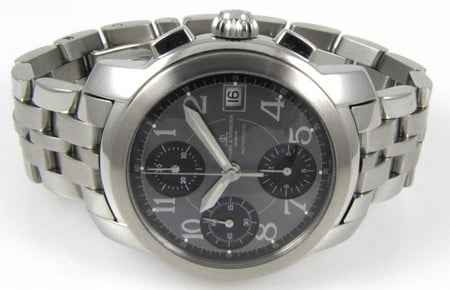Baume & Mercier is one of the fastest growing high-end brands in the United States over the past decade. It is currently a part of the luxury giant Richemont. Under the Richemont group it is in the company of a number of watchmaking legends including IWC, Jaeger-LeCoultre, Officine Panerai and Vacheron Constantine.
 Baume & Mercier traces its watchmaking roots back more than 175 years to the Baume brothers who made fob watches as early as 1830. While many watch brands lay claim to a historical lineage, very few can claim their uninterrupted history of watchmaking. Since its inception as Frerers Baume (Baume Brothers), by Louis Victor Baume and Pierre-Joseph-Celestine Baume, the brand has changed hands many times, but it has never ceased operation. Few know that it is the 6th oldest watch company in existence. For those of you keeping track – number one is Blancpain (1735) followed by Vacheron Constantin (1755), Breguet (1775), Chaumet (1780) and Girard Perregaux (1791).
Baume & Mercier traces its watchmaking roots back more than 175 years to the Baume brothers who made fob watches as early as 1830. While many watch brands lay claim to a historical lineage, very few can claim their uninterrupted history of watchmaking. Since its inception as Frerers Baume (Baume Brothers), by Louis Victor Baume and Pierre-Joseph-Celestine Baume, the brand has changed hands many times, but it has never ceased operation. Few know that it is the 6th oldest watch company in existence. For those of you keeping track – number one is Blancpain (1735) followed by Vacheron Constantin (1755), Breguet (1775), Chaumet (1780) and Girard Perregaux (1791).
Freres Baume officially became Baume & Mercier in 1918 when William Baume (grandson of Louis Victor Baume) joined the family business to that of jeweler Paul Mercier. By the time both Baume & Mercier retired from active roles in the company in 1937, the company had a well-established distribution network in five continents. The company boasts the largest distribution network in the Richemont group, with over 300 points of sale worldwide.
Baume & Mercier was purchased in 1964 by jeweler and watch manufacturer Piaget. The Piaget ownership contributed to the brand by adopting the Greek letter Phi and its associated Golden Ratio as symbols for Baume & Mercier. Piaget also provided technical expertise in the form of ultra-slim movements. Watches from this period are often found with Piaget movements. Also under the Piaget leadership, in 1973 Baume & Mercier introduced the Riviera, with its unique dodecahedral case. In production for more than 30 years this style has been integral to the brand’s success.
When Cartier launched their takeover of Piaget in 1988, control of Baume & Mercier came with it. Shortly thereafter, in 1993 all three brands were enveloped within the Vendôme Group, which was bought out by the Richemont group in 1998.

Shortly after being acquired by the Vendôme group, Baume & Mercier introduced their flagship Hampton line. The commercial success of the Hampton was rapidly followed by the Hampton Milleis, Hampton Spirit and Hampton City.
During this tumultuous period Baume & Mercier wavered between moving up market and moving into the fashion sector. Recently the brand has begun to emerge with a clearer vision under the leadership of the new CEO Michel Nieto. Baume & Mercier opened a new manufacture in Brenets in 2004. At the same time the company has retained a good price to quality ratio that enables them to stay on the forward edge of style with new models such as the Diamant and the Vice Versa, as well as reinvented versions of the Classima and Riviera. The company intends to remain a brand of volume; recent estimates put their sales at more than 200,000 pieces per year.